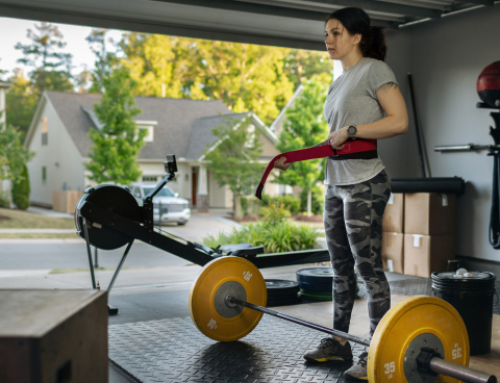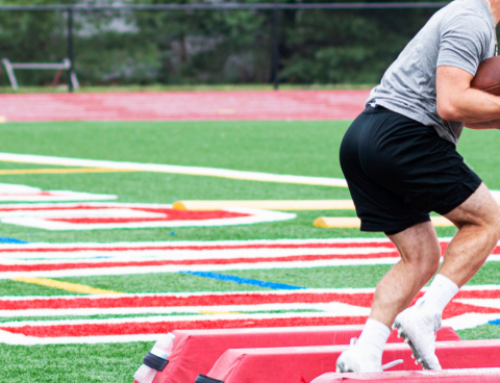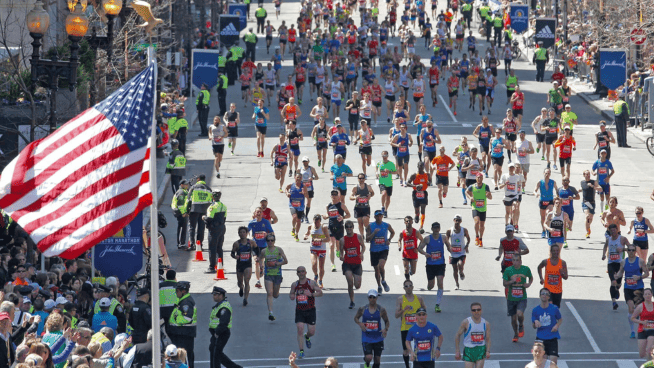Run Downhill for Bulletproof Knees
We’ve all heard it – uphill is the hard part, downhill is the easy part! Years ago, a friend mentioned that downhill running is not so easy. That didn’t make sense to me until I studied Exercise Science and understood why she was right.
While uphill work gets the heart pumping, downhill running is surprisingly taxing. Running downhill places unique demands on your hips and knees, enhancing performance for many sports and preventing injury.
Why Downhill Work Is Valuable (and Underrated)
Injury Prevention
Downhill movement strengthens the quads and patellar tendons in the knee. This is essential, as many running injuries relate to weaknesses in this area. Conversely, uphill runs strengthen your hips.
Performance Boost
A strong patellar tendon improves stride power and running efficiency. It is like adding an incline bench press to enhance your flat bench. Stronger quads and tendons from downhill running translate to a more powerful and efficient stride.
Enhanced Stability
Stability is vital for our body’s movement and coordination. It helps us walk, run, and move around without falling. In sports and exercise, stability is crucial because it is essential for agility. Stability allows you to move explosively and with power. If your joints lack stability, especially in the knees, it slows you down and makes it harder to move quickly. You can become more agile and improve overall coordination by enhancing your body’s ability to stabilize and handle more force.
Body Awareness and Coordination
Downhill running hones your sense of your body’s position in space (proprioception) and improves the interplay between your muscles and nervous system. These adaptations make changes in directions smoother and faster.
The Science of Downhill Training
It’s not about mindlessly bombing down hills. Controlled downhill running focused on the ankles’ and knees’ eccentric phase is first. Downhill running, done slowly and controlled first eccentrically, strengthens the tendons and muscles surrounding these joints, providing a foundation for better shock absorption.
Eccentrically strong muscles are better at controlling deceleration forces. This is crucial for reducing strain on tendons and joints, especially in activities with many changes in direction and stopping. Consider eccentric training as a way to armor your body against common injuries in general and for sports.
Enhanced Neuromuscular Coordination
Eccentric training stimulates both muscle spindles (which sense changes in muscle length) and Golgi Tendon Organs (GTOs, which sense tension). The increased communication between these sensory organs improves your body’s ability to coordinate precise movements and teaches muscles to absorb force effectively before powerfully transitioning to a concentric contraction. Stronger muscles in the eccentric phase allow for greater energy storage and return. This makes movements like running or jumping feel more effortless and improves your ability to generate power during the concentric phase of muscle contractions.
This eccentric loading strengthens the quads, patellar tendon, and other muscles and tendons in your knees and lower legs. These are all essential structures for absorbing impact and generating power during running, walking, etc.
Improved Stride Efficiency
Going downhill puts a strong emphasis on the eccentric phase of your stride (when your muscles lengthen under tension).
Stretch Shortening Cycle
Eccentric training improves the stretch-shortening cycle of your muscles, meaning you get more energy return as you transition from the eccentric to the concentric phase of your run. This can make you faster with less effort. You create greater energy storage and release potential by strengthening a movement’s eccentric (lengthening) phase. This translates to more power and explosiveness in the concentric (shortening) phase, like when you push off the ground in a sprint.
Increased Strength
The increased force during eccentric movements causes more micro-tears in muscle fibers. As these repairs, the muscle grows larger and stronger. Eccentric contractions generate more force than concentric (shortening) movements. Training eccentrically helps you recruit more muscle fibers, leading to significant strength gains.
Rehabilitation
Eccentric training is often used in physical therapy to help regain strength after an injury. Its controlled nature can be beneficial in the recovery process.
Important Notes
Downhill running shouldn’t replace your regular training entirely. It’s a powerful tool that should be strategically integrated into your training program.
- Proper form is crucial to prevent injuries on downhills. It involves a shorter stride, maintaining control, and avoiding overstriding.
- Consult a coach or trainer to integrate downhill running safely, especially if you’re new to this type of work.
Who Can Benefit Most from Downhill Training?
While anyone can incorporate downhill movement into their workouts, athletes in these sports often see tremendous gains:
- Trail Runners: Navigating technical descents safely and quickly is essential for trail running success. Downhill training builds lower body strength specifically geared towards this type of terrain.
- Soccer Players: Constant changes in direction and explosive sprints put a lot of stress on the knees. Downhill work strengthens these vulnerable areas.
- Basketball Players: Jumping, landing, and sudden stops are common in basketball. The focus on knee stability gained from downhill training can help reduce the risk of injury.
- Others: Anyone who plays a sport or position where deceleration and speed are needed. Or who want to strengthen their knees.
Downhill Running Training Programs
Downhill Strength Training
- Slow Walking- Walk down a hill or incline slowly, taking about 30 seconds to complete the walk. Rest for 2 minutes and perform again. Do it five times. Once you are comfortable, add resistance, like carrying a light medicine ball or sandbag.
- Strength Endurance Drill- Downhill Trail Running with Obstacles: Find a trail with natural obstacles like rocks or tree roots. The uneven terrain will engage various muscle groups.
Downhill Endurance Training
- Long Downhill Runs- Increase the duration of your downhill runs gradually. Start with 30 minutes and add 5-10 minutes each week until you reach your desired duration.
- Interval Downhill Runs- Incorporate intervals into your downhill runs. For example, run at a challenging pace for 2 minutes, followed by a slower recovery pace for 1 minute. Repeat for the desired duration.
Downhill Speed Training
- Downhill Sprints- Perform short, intense downhill sprints. Start with 8-10 sets of 20-30 seconds, focusing on maximum speed and proper form.
- Speed Intervals- Mix short and long downhill intervals. For instance, alternate between 1-minute sprints and 3-minute recovery jogs. Gradually increase the intensity and duration.
- Downhill Strides- Add downhill strides to the end of your regular runs. Stride at near-maximum speed for 50-100 meters, focusing on quick turnover and proper form.
Downhill Intermittent Training
- Fartlek Downhill Runs- During a downhill run, incorporate bursts of speed at irregular intervals. For example, sprint between two landmarks then recovers slower before the next burst.
- Hill Repeats- Choose a downhill slope and perform hill repeats. Run at a challenging pace downhill for a specific duration, then jog back up.
Before you begin any training program, go slow, especially running downhill, because you can fall as speed increases. So, ensure your shoelaces are doubled-tied and tight to avoid tripping.
RECOMMENDED FOR YOU
MOST POPULAR
Run Downhill for Bulletproof Knees
We’ve all heard it – uphill is the hard part, downhill is the easy part! Years ago, a friend mentioned that downhill running is not so easy. That didn’t make sense to me until I studied Exercise Science and understood why she was right.
While uphill work gets the heart pumping, downhill running is surprisingly taxing. Running downhill places unique demands on your hips and knees, enhancing performance for many sports and preventing injury.
Why Downhill Work Is Valuable (and Underrated)
Injury Prevention
Downhill movement strengthens the quads and patellar tendons in the knee. This is essential, as many running injuries relate to weaknesses in this area. Conversely, uphill runs strengthen your hips.
Performance Boost
A strong patellar tendon improves stride power and running efficiency. It is like adding an incline bench press to enhance your flat bench. Stronger quads and tendons from downhill running translate to a more powerful and efficient stride.
Enhanced Stability
Stability is vital for our body’s movement and coordination. It helps us walk, run, and move around without falling. In sports and exercise, stability is crucial because it is essential for agility. Stability allows you to move explosively and with power. If your joints lack stability, especially in the knees, it slows you down and makes it harder to move quickly. You can become more agile and improve overall coordination by enhancing your body’s ability to stabilize and handle more force.
Body Awareness and Coordination
Downhill running hones your sense of your body’s position in space (proprioception) and improves the interplay between your muscles and nervous system. These adaptations make changes in directions smoother and faster.
The Science of Downhill Training
It’s not about mindlessly bombing down hills. Controlled downhill running focused on the ankles’ and knees’ eccentric phase is first. Downhill running, done slowly and controlled first eccentrically, strengthens the tendons and muscles surrounding these joints, providing a foundation for better shock absorption.
Eccentrically strong muscles are better at controlling deceleration forces. This is crucial for reducing strain on tendons and joints, especially in activities with many changes in direction and stopping. Consider eccentric training as a way to armor your body against common injuries in general and for sports.
Enhanced Neuromuscular Coordination
Eccentric training stimulates both muscle spindles (which sense changes in muscle length) and Golgi Tendon Organs (GTOs, which sense tension). The increased communication between these sensory organs improves your body’s ability to coordinate precise movements and teaches muscles to absorb force effectively before powerfully transitioning to a concentric contraction. Stronger muscles in the eccentric phase allow for greater energy storage and return. This makes movements like running or jumping feel more effortless and improves your ability to generate power during the concentric phase of muscle contractions.
This eccentric loading strengthens the quads, patellar tendon, and other muscles and tendons in your knees and lower legs. These are all essential structures for absorbing impact and generating power during running, walking, etc.
Improved Stride Efficiency
Going downhill puts a strong emphasis on the eccentric phase of your stride (when your muscles lengthen under tension).
Stretch Shortening Cycle
Eccentric training improves the stretch-shortening cycle of your muscles, meaning you get more energy return as you transition from the eccentric to the concentric phase of your run. This can make you faster with less effort. You create greater energy storage and release potential by strengthening a movement’s eccentric (lengthening) phase. This translates to more power and explosiveness in the concentric (shortening) phase, like when you push off the ground in a sprint.
Increased Strength
The increased force during eccentric movements causes more micro-tears in muscle fibers. As these repairs, the muscle grows larger and stronger. Eccentric contractions generate more force than concentric (shortening) movements. Training eccentrically helps you recruit more muscle fibers, leading to significant strength gains.
Rehabilitation
Eccentric training is often used in physical therapy to help regain strength after an injury. Its controlled nature can be beneficial in the recovery process.
Important Notes
Downhill running shouldn’t replace your regular training entirely. It’s a powerful tool that should be strategically integrated into your training program.
- Proper form is crucial to prevent injuries on downhills. It involves a shorter stride, maintaining control, and avoiding overstriding.
- Consult a coach or trainer to integrate downhill running safely, especially if you’re new to this type of work.
Who Can Benefit Most from Downhill Training?
While anyone can incorporate downhill movement into their workouts, athletes in these sports often see tremendous gains:
- Trail Runners: Navigating technical descents safely and quickly is essential for trail running success. Downhill training builds lower body strength specifically geared towards this type of terrain.
- Soccer Players: Constant changes in direction and explosive sprints put a lot of stress on the knees. Downhill work strengthens these vulnerable areas.
- Basketball Players: Jumping, landing, and sudden stops are common in basketball. The focus on knee stability gained from downhill training can help reduce the risk of injury.
- Others: Anyone who plays a sport or position where deceleration and speed are needed. Or who want to strengthen their knees.
Downhill Running Training Programs
Downhill Strength Training
- Slow Walking- Walk down a hill or incline slowly, taking about 30 seconds to complete the walk. Rest for 2 minutes and perform again. Do it five times. Once you are comfortable, add resistance, like carrying a light medicine ball or sandbag.
- Strength Endurance Drill- Downhill Trail Running with Obstacles: Find a trail with natural obstacles like rocks or tree roots. The uneven terrain will engage various muscle groups.
Downhill Endurance Training
- Long Downhill Runs- Increase the duration of your downhill runs gradually. Start with 30 minutes and add 5-10 minutes each week until you reach your desired duration.
- Interval Downhill Runs- Incorporate intervals into your downhill runs. For example, run at a challenging pace for 2 minutes, followed by a slower recovery pace for 1 minute. Repeat for the desired duration.
Downhill Speed Training
- Downhill Sprints- Perform short, intense downhill sprints. Start with 8-10 sets of 20-30 seconds, focusing on maximum speed and proper form.
- Speed Intervals- Mix short and long downhill intervals. For instance, alternate between 1-minute sprints and 3-minute recovery jogs. Gradually increase the intensity and duration.
- Downhill Strides- Add downhill strides to the end of your regular runs. Stride at near-maximum speed for 50-100 meters, focusing on quick turnover and proper form.
Downhill Intermittent Training
- Fartlek Downhill Runs- During a downhill run, incorporate bursts of speed at irregular intervals. For example, sprint between two landmarks then recovers slower before the next burst.
- Hill Repeats- Choose a downhill slope and perform hill repeats. Run at a challenging pace downhill for a specific duration, then jog back up.
Before you begin any training program, go slow, especially running downhill, because you can fall as speed increases. So, ensure your shoelaces are doubled-tied and tight to avoid tripping.












